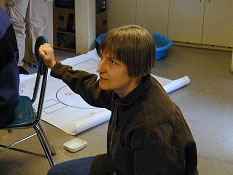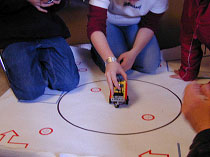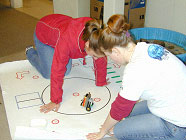
Ms.
Barbara Bratzel is a teacher at Shady Hill School, a preK through 8 independent school in
Cambridge, Massachusetts. Barbara teaches at both ends of the school spectrum, currently
teaching both kindergarten science and eighth-grade physics. This is her fifteenth year
at Shady Hill, before which she taught math and biology in both middle and high
school.
Barbara first became interested in teaching math and science through
engineering about 10 years ago. Chris Rogers, a professor in Mechanical
Engineering at Tufts University’s School of Engineering, brought a portable
wind tunnel to Shady Hill and tested it with Barbara’s third grade class.
Barbara says that, “The kids loved it!” Once her interest in engineering was
sparked, Barbara continued to work with Chris on other projects. Through her
increased interest in the subject, Barbara created Physics by Design, which
is an eighth-grade class that teaches physics through engineering. Four
years ago this course was an experimental course, now it has become an
established part of the eighth grade curriculum at Shady Hill.

When
asked about her comfort level with engineering, Barbara revealed that she feels quite
comfortable in teaching the engineering component. She continues that, “Though I have
learned a lot on my own, I wish that I had formal training in engineering.” Barbara’s
enthusiasm for the subject shows through in her Physics by Design course. Through the
student grapevine the class has become known as a course that should not be missed.
Barbara states that “often more students sign up to take it than we are able to
accommodate.”
Another
component that Barbara uses in her classes is robotic LEGO units. Through the design
challenges that she sets forth students explore a math or science principle through
engineering using LEGO manipulatives. When asked how her students respond to the
engineering based lessons, Barbara answers, “The students love them, particularly
those involving LEGO and RoboLab.”
 Barbara states that the engineering projects make physics come alive.
“Physics goes from being something abstract to being something they can apply
right away. I try to make the building projects tie in fairly closely with
the curriculum. For example, after studying torque and center of gravity,
the students build balances out of LEGO that are accurate to within half a
gram. You cannot make that precise a balance without dealing with center-of
gravity and torque issues, so the students are forced to use what they have
learned.”
Barbara states that the engineering projects make physics come alive.
“Physics goes from being something abstract to being something they can apply
right away. I try to make the building projects tie in fairly closely with
the curriculum. For example, after studying torque and center of gravity,
the students build balances out of LEGO that are accurate to within half a
gram. You cannot make that precise a balance without dealing with center-of
gravity and torque issues, so the students are forced to use what they have
learned.”
One
of the problems in offering an engineering course can be the accumulation of materials.
In response to this, Barbara looked to LEGO as a source of non-consumable materials.
“To make the class go smoothly, I find that I need a computer for every lab group and
plenty of LEGO. Luckily, I’ve now got a classroom set of laptops and small mountain of
LEGO.” It does however take some time to acquire the materials, but every year the
supply becomes larger and more diverse.
 As words of advice for other teachers considering adding engineering
to their curriculum, Barbara says that the trouble it takes is well worth
it. It becomes interesting and engaging for the students as well as the teacher.
“Teaching engineering has allowed me to become a coach more than a teacher...Much
of the learning occurs naturally as they work on their projects.”
As words of advice for other teachers considering adding engineering
to their curriculum, Barbara says that the trouble it takes is well worth
it. It becomes interesting and engaging for the students as well as the teacher.
“Teaching engineering has allowed me to become a coach more than a teacher...Much
of the learning occurs naturally as they work on their projects.”
|